Industrial Agriculture 101
Giant farms—whether growing crops or animals—often rely heavily on chemicals and produce waste that pollutes the water and air. As a result, the system we’ve designed to feed the planet also takes a serious toll on its health.
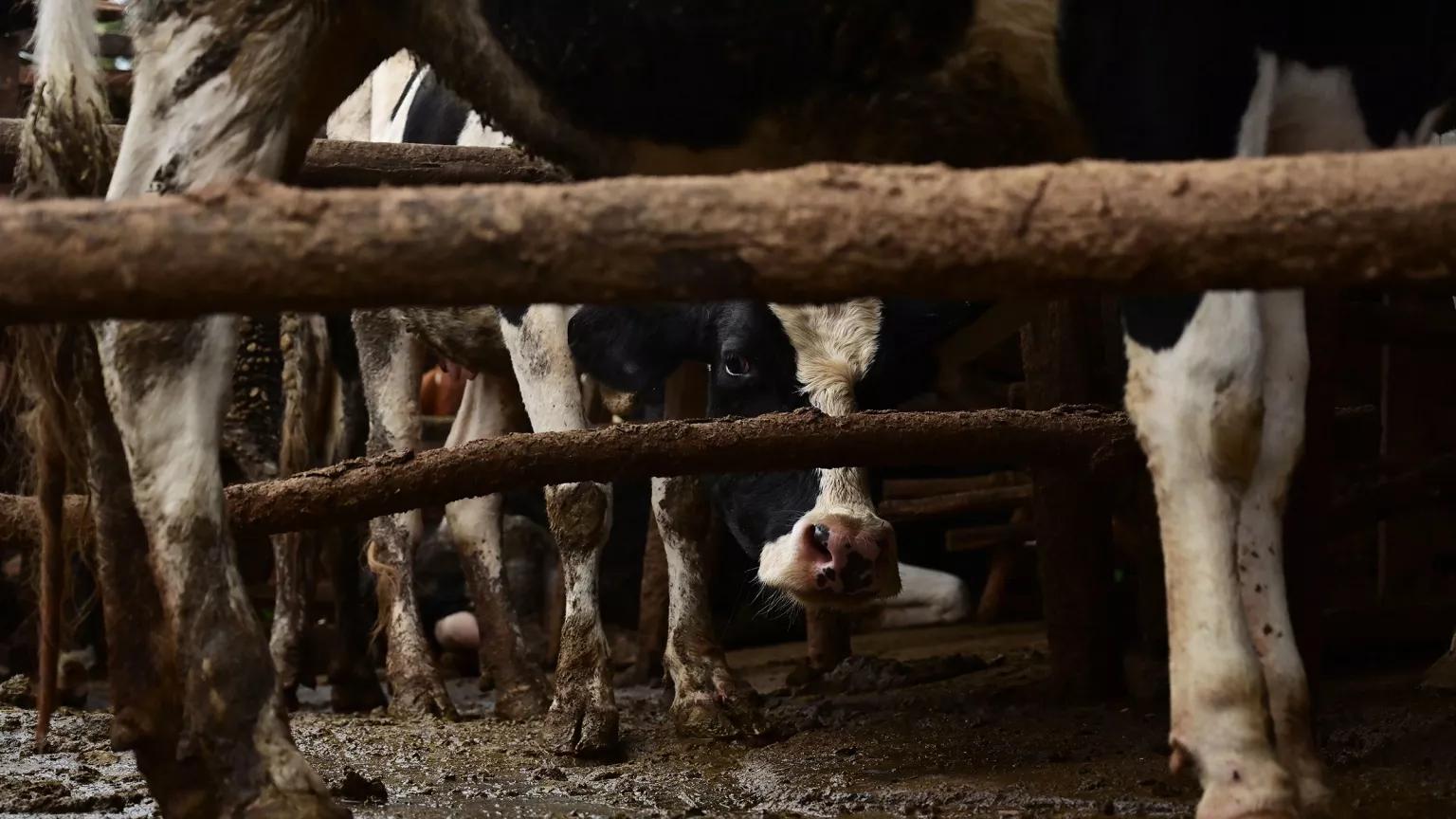
Dairy cows in a pen
Tony Karumba/AFP/Getty
Jump to Section
- What Is Industrial Agriculture?
- What Is a CAFO?
- What Are GMOs?
- What Is Monoculture?
- Impacts of Industrial Agriculture
- Fighting Dangerous Practices in Unsustainable Industrial Agriculture
- Alternatives to Industrial Agriculture
What Is Industrial Agriculture?
Industrial agriculture is the large-scale, intensive production of crops and animals, often involving chemical fertilizers on crops or the routine, harmful use of antibiotics in animals (as a way to compensate for filthy conditions, even when the animals are not sick). It may also involve crops that are genetically modified, heavy use of pesticides, and other practices that deplete the land, mistreat animals, and increase various forms of pollution. In recent decades, consolidation in the industry has intensified as agriculture has undergone what is known as “vertical integration,” a transition from small, diverse farms producing a variety of crops and livestock to an industrialized system dominated by big multinational corporations. These corporations reap the benefits while farmers, growers, and their workers see their profits evaporate, even as the health burdens of industrial practices increase.
What Is a CAFO?
The term “factory farm” is commonly used to refer to large, industrialized facilities raising animals for food, but it isn’t a legal or scientific term. The official name for these facilities is concentrated animal feeding operations, or CAFOs. The term refers to a facility that keeps a very large number of live animals confined for more than 45 days per year and brings food into their enclosures rather than allowing them to graze. According to the U.S. Environmental Protecion Agency (EPA), a “large CAFO” typically has at least 1,000 beef cattle, 700 dairy cows, 2,500 large pigs, or 82,000 egg-laying hens. There are separate definitions for medium-size and small CAFOs.
Policymakers have long known that big CAFOs can mean big pollution. In the original 1972 Clean Water Act, lawmakers recognized that CAFOs are industrial polluters just like factories and required the EPA to regulate them the same way. However, those regulations have fallen flat in practice.
In addition to pollution, these operations raise serious animal welfare concerns. Unfortunately, federal legislation—like the Animal Welfare Act and the Humane Slaughter Act—has not done enough to make CAFOs more humane. To this day, many facilities use practices like tail docking without pain medications or shut egg-laying hens in battery cages for their entire lives—cages so small and crowded that the birds cannot even stand up or turn around.
Despite increased public awareness about the dangers of large CAFOs, the number of animals in CAFOs across the country has continued to grow, as has the size of the facilities themselves. According to the U.S. Department of Agriculture, the average dairy farm grew from just 19 cows in 1970 to 120 in 2006, and today’s biggest farms have more than 15,000 cattle. The average pig farm grew from 945 animals in 1992 to 4,646 in 2004, with the animals often confined to spaces only slightly larger than their bodies. As we reported in 2019, a decade of NRDC research finds that the EPA has left health threats largely unmonitored and lacks basic information about most CAFOs, including their location, how many animals they confine, and how much waste they produce. CAFOs remain harmful to the environment, to the health of nearby communities, and are terrible for animal welfare.
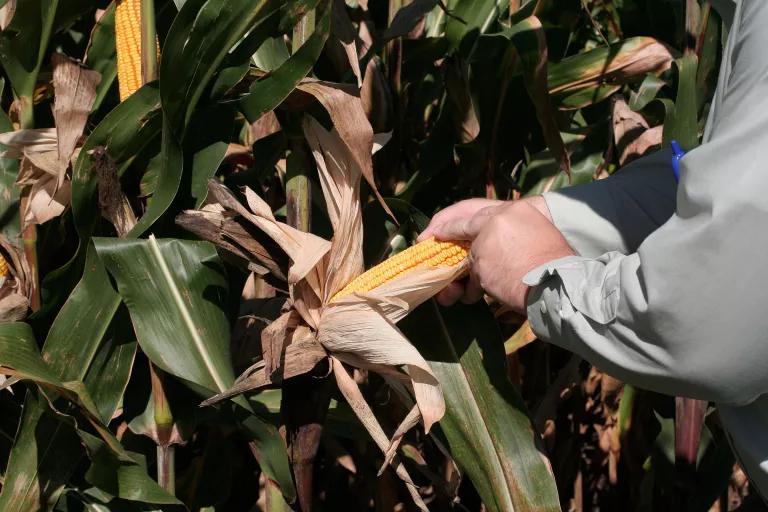
Lyroky/Alamy
What Are GMOs?
Humans have been genetically modifying plants for thousands of years. But we used to do it the old-fashioned way—by selection. Ancient farmers planted seeds from only the sweetest fruits, generation after generation, ensuring that any genetic variations that increased sweetness survived. By selecting plants with increasingly white, increasingly tiny, flowers, farmers turned a weedy little herb into cauliflower. It was slow but effective.
Modern genetic modification is done in laboratories. Scientists start by identifying candidate genes for desired traits, like resistance to drought or heat. The gene doesn’t have to come from a plant. Researchers can implant a gene from a fungus, bacterium, or animal.
So how are modern GMOs, or genetically modified organisms, made? Once a potentially useful gene is identified, researchers make millions of copies of that piece of genetic code. To then get that gene into the target plant, they can spread the genes onto a tiny piece of tungsten or gold, shoot that into the target plant cell, and hope that some of the genes will integrate into the plant’s DNA.
A more sophisticated approach is to use agrobacteria. In the wild, these microbes invade plant cells and insert a genetic sequence into their DNA that forces the plant to make food for the agrobacteria. That’s a pretty handy trick. And researchers have figured out a way to get agrobacteria to introduce other genes into plant DNA, like genes that increase drought tolerance. “Marker genes” that ride along with the implanted gene help scientists confirm that the plant has adopted the new DNA.
Then comes the testing process. Researchers raise several generations of the transgenic plant to make sure the new genetic sequence is viable. They also make sure that the new gene is actually conferring a trait, like drought resistance, to the plant. Genetically modified foods are tested to ensure that they contain the same levels of nutrients as the original, but they are not generally tested for safety. While some animal studies are conducted to ensure the proteins that an introduced gene produces are safe for consumption, long-term health risks are difficult to assess. Many people have called for mandatory labeling of GMO foods.
From an environmental perspective, however, there can be problems with GMOs. One of the most common uses of genetic modification is to give corn or soy plants the ability to survive exposure to certain herbicides like Roundup, a glyphosate-based product, and 2,4-D. This way, farmers can spray herbicides on their fields and the only plants left standing will be the GMO crop.
The problem with this strategy is that any weeds that survive the chemical onslaught begin to develop resistance to the herbicide. This prompts farmers to spray more and more chemicals onto their fields. Huge doses of pesticides are bad for the environment generally, but there are specific cases where the chemicals have done especially serious damage. For instance, monarch butterflies rely on a healthy population of milkweed, a plant that used to be commonly found in agricultural fields across the midwestern United States. But widespread application of glyphosate-based products like Roundup, in connection with genetically engineered crops, has contributed to the destruction of milkweed. Monarchs are suffering as a result of this and other assaults to its fragile life cycle. Over the past 15 years, the monarch butterfly population has dropped more than 80 percent.
Glyphosate also endangers human health. Recent studies confirm it carries a risk of cancer, and it may be linked to other adverse health impacts affecting reproduction, child development, and internal organs.
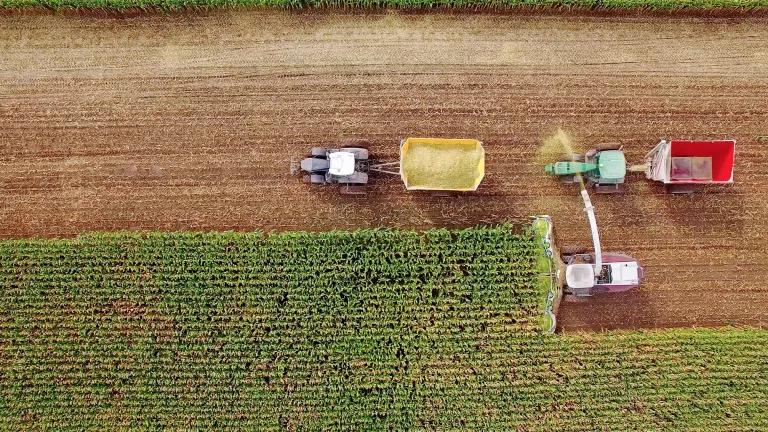
James Brey/iStock
What Is Monoculture?
Monoculture is the planting of a single crop on the same farmland year after year, a practice that is extremely bad for soil health. Planting the same crop over and over again depletes soil nutrients, which often leads farmers to apply large amounts of synthetic fertilizers—something that further degrades soil health in the long run. Monoculture also renders the soil prone to rapid erosion, since the practice leaves the soil bare outside of the crop’s growing season. Perhaps more problematically, repeatedly planting the same crop invites pests that prey on a certain plant to wait around the same spot for their favorite food to return.
What are conventional farmers left to do to avoid pests? Apply pesticides. That’s why monoculture and genetic modification tend to go hand in hand. Planting pesticide-tolerant GMO crops enables farmers to blanket the landscape with chemicals without damaging their corn or soy. (Speaking of corn and soy, many U.S. farmers rotate their fields back and forth between those two crops, leading to a duoculture that’s only slightly less damaging to the soil than a monoculture.)
Impacts of Industrial Agriculture
The environmental impacts of industrial crop farming and CAFOs are significant. There is soil depletion and soil infertility related to monoculture, soil erosion, water pollution, loss of biodiversity, increased greenhouse gas emissions (particularly methane and nitrous oxide) from cow digestion and manure as well as nitrogen-based fertilizers, and pesticide overuse leading to potential pesticide toxicity (especially in farmworkers). Studies show that employees of CAFOs are at risk from potentially deadly antibiotic-resistant bacteria; workers can also bring these bacteria home. Farmworkers and local communities can also be exposed to hazardous fumes wafting from unlined, uncovered pits of animal waste and other sources. And despite the fact that CAFOs often must meet permitting requirements and are regulated by both state and federal agencies, NRDC has discovered a worrying lack of transparency. Discrepancies between data collected by states and the EPA suggest the EPA is unaware of the size, number, and location of CAFOs across the country and what those operations are doing to control pollution. And that’s just for starters. Here are some areas of particular concern.
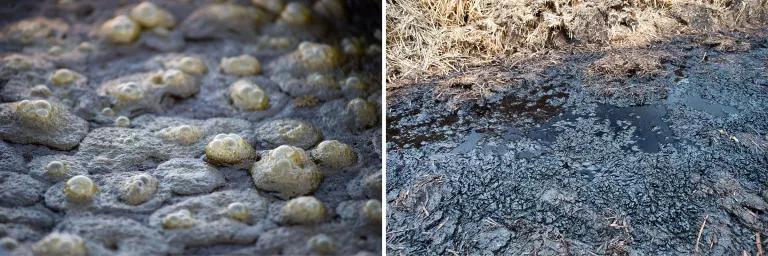
Left: Methane bubbles from a manure pit digester on a dairy farm. Right: Liquid leaches from a manure pile.
Left: Edwin Remsberg/Alamy. Right: Ashley Cooper/Alamy
Water pollution
In 2012 livestock and poultry raised in the largest CAFOs in the United States produced 369 million tons of manure, according to an analysis of USDA figures done by Food & Water Watch. All that waste has to go somewhere.
Many hog and dairy farms maintain huge pools of liquid manure and urine and often dispose of waste simply by spreading it over the fields. Industry says it serves as fertilizer, but the land’s demand for nutrients may not match the output of hundreds of thousands of animals. As a result, farmers often apply too much, the soil fails to absorb all of the phosphorus and nitrogen, and the excess nutrients seep into groundwater or run off into waterways, which empty into the sea. Waste from birds matters, too: Poultry farms usually use a system of dry litter and store the birds’ feces, used bedding, and shed feathers in large, exposed mounds. The feces is higher in phosphorus than other animal waste and pollutes waterways with runoff.
The nutrients in the sea then trigger an overgrowth of algae. In a harmful algal bloom, algae and algaelike bacteria can release toxins harmful to people, pets, and the ecosystem as a whole. As the algae (toxic and nontoxic) eventually die off, aerobic bacteria use oxygen to decompose them. It’s a dangerous chain of events: Without oxygen, the water cannot support other marine life. The result is aquatic dead zones, which have been getting larger and more frequent in recent decades, and. And it’s not just in the ocean. Within the world’s largest freshwater ecosystem, Lake Erie experiences a dead zone every summer.
Additionally, manure lagoons are vulnerable to spilling over during extreme weather. If the manure line rises too high, a heavy rain will overtop the lagoon, flooding the surrounding area with dangerous animal waste.
Overtopping events happen with alarming frequency. In 1999 Hurricane Floyd caused severe flooding and compromised more than 50 manure lagoons in North Carolina. (It also killed many tens of thousands of hogs.) The waste-laden floodwaters exposed communities to bacteria, a microbial threat that persisted even after the waters receded. In 2016, Hurricane Matthew hit the state and caused damage visible from space, partially submerging 10 industrial pig farms that included 14 open-air pits holding millions of gallons of liquid hog manure. In September 2018, Hurricane Florence compromised or put at risk 110 hog lagoons. When combined with sewage, the disaster dumped more than 39 million gallons of waste into the Cape Fear River Basin, a source of drinking water to large North Carolina communities like Fayetteville and Wilmington.
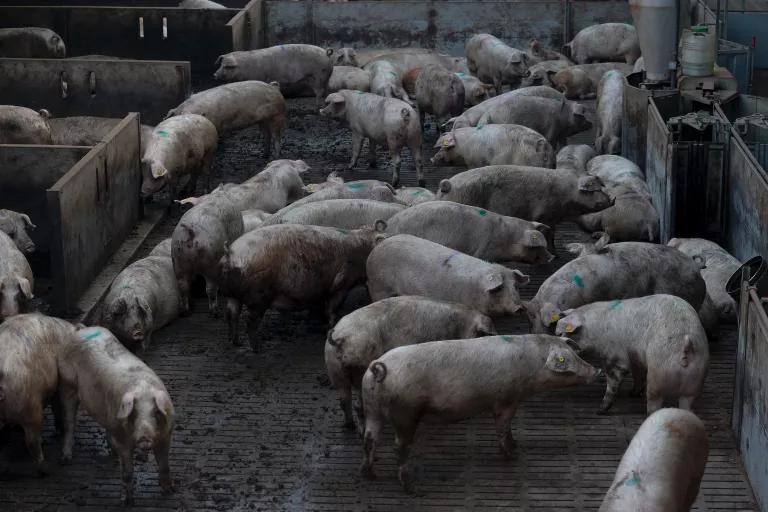
Josep Lago/Stringer/AFP via Getty Images
Antibiotic resistance
Industrial farms overuse antibiotics, feeding large amounts of the drugs—often the same ones used to treat human illnesses—to healthy animals to help them survive in crowded, dirty CAFOs. Low-level exposure to antibiotics creates the perfect breeding ground for superbugs, those pathogens that antibiotics can’t kill. In some cases, pathogens have developed resistance to all available antibiotics. Resistant bacteria can then spread to human populations such as the communities neighboring these farms. They contaminate the soil. And, when rains overtop the manure lagoons, antibiotic-resistant bugs can slip into the water supply, endangering the health even of people who don’t live near a CAFO.
Despite the growing awareness of these risks, many big companies that dictate practices at CAFOs continue to require operators to use antibiotics that are important to human medicine.
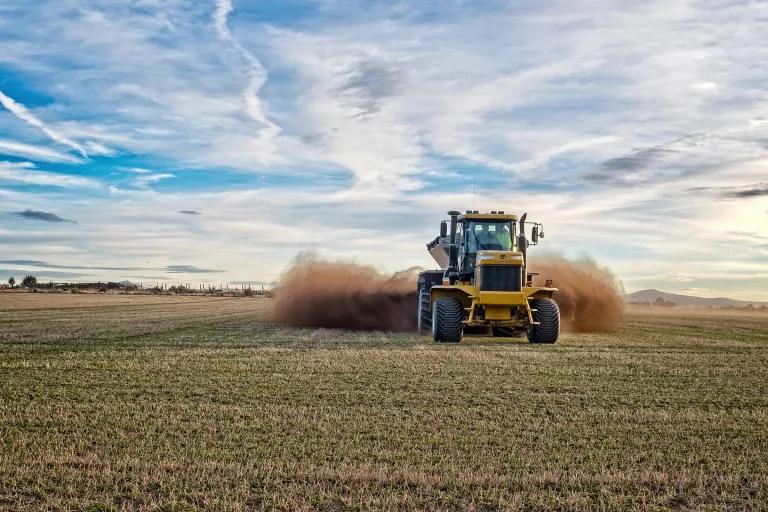
A tractor spreading manure over a field
Charles Leutwiler/Alamy
Air pollution
Studies in the United States and around the world have shown that industrial farming has become the leading source of particulate matter air pollution, which can penetrate human lungs and enter the circulatory system. CAFOs also emit industrial-level amounts of hydrogen sulfide and ammonia (released by the massive amounts of animal waste), yet they are exempt from the laws that require other industries to disclose these emissions and reduce outdoor air pollution.
The federal government has done a poor job of controlling air pollution from the agriculture industry and protecting the communities that live near farms. The EPA has failed even to develop a reliable method to measure this pollution.
Fighting Dangerous Practices in Unsustainable Industrial Agriculture
NRDC has worked for years to stop the unnecessary use of routine antibiotics on livestock farms. The campaign has successfully pressured large restaurant chains and corporate farms to institute limits on antibiotic use in chicken, pork, and beef, and efforts to protect the efficacy of antibiotics continue. NRDC has also campaigned against massive manure lagoons, winning state-level legislation to stop the growth of this environmentally disastrous practice.
Big agribusiness companies have worked to get laws passed that help veil their practices in secrecy by banning video-taking and other reporting practices on CAFO property. Some so-called ag-gag laws even go so far as to criminalize the gathering of information that has always been available to the public—basic information about what happens at these facilities. NRDC and our partners have challenged these censorship laws in court, and some have been deemed unconstitutional for violating the First Amendment.
Groups like the Humane Society of the United States and Farm Sanctuary have partnered with states to make practices at industrial facilities more humane. As of this writing, nine states have banned the use of gestation crates, or steel boxes in which pregnant pigs can neither turn around nor lie down. Eight states have outlawed veal crates, while five states have passed laws to limit the use of battery cages, which cram chickens in groups of 5 to 10 each into tiny spaces.
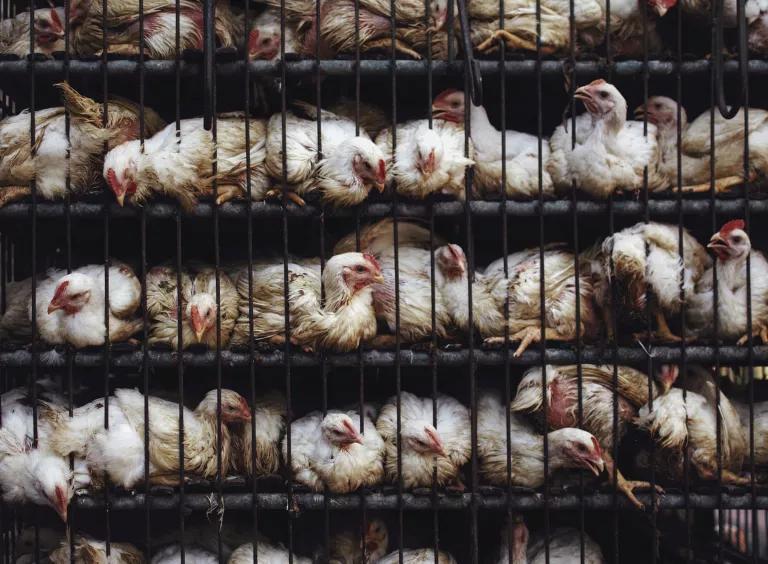
Broiler chickens in stacked wire cages
Stocksy
Alternatives to Industrial Agriculture
Human agriculture has existed for about 12,000 years, and industrial farming is less than a century old. But the latter has become so prevalent that sustainable farming practices are now sometimes branded “alternative.”
Many academics have pointed out that the growth of industrial agriculture was not entirely a response to demand for more food from less land; there are many options to increase productivity without mistreating the environment or livestock. Rather, systemic incentives have helped lock in common practices of factory farming and monoculture. The U.S. Farm Bill basically ensures massive production of corn, typically the genetically modified version on monoculture fields. The U.S. government has also offered industrial farms huge payments to help them manage their manure pools. Congress has managed to make a bad system worse by reducing funding for good programs like the Conservation Stewardship Program, one of the few pro-environment features of our federal incentive system.
Regenerative farmers are leading a new movement to reduce the use of fertilizers and pesticides through improved soil health and diverse crop rotations. Low-confinement systems of animal production not only benefit the health and well-being of livestock but also offer significant environmental benefits. Unconfined animals graze, reducing the need for massive corn farms and resulting in the production of less greenhouse gas. Manure management is also improved, as grazing animals increase soil health and reduce the need to concentrate animal waste in holding pools that can overflow into drinking water systems and lead to aquatic dead zones.
Organic agriculture has expanded enormously in recent years. Sales of organic food increased from just $15 billion in 2006 to more than $50 billion in 2018. Farmers are responding to that demand. There was a 56 percent increase in the number of certified organic farms nationwide between 2011 and 2016.
This is all happening in a system that disincentivizes progressive farming approaches by reinforcing monoculture farming via a flawed crop insurance program that renders the land more vulnerable to the impacts of climate change. In addition, our government continues to license cheap but environmentally damaging pesticides that wipe out complex ecosystems. Imagine the potential effect of better policies, including increased research on organic farming techniques to protect people and our planet, giving farmers of color more access to land and credit, and a crop insurance program that does not encourage monocultures but supports crop rotation and good soil health practices instead.
You can take steps to reduce industrial farming. Buy organic and avoid meat produced on CAFOs. Purchase from regenerative farms—or even create a mini farm in your own backyard. Incorporate more plant-based foods into your diet. Above all, stay informed and spread the message.
This NRDC.org story is available for online republication by news media outlets or nonprofits under these conditions: The writer(s) must be credited with a byline; you must note prominently that the story was originally published by NRDC.org and link to the original; the story cannot be edited (beyond simple things such as grammar); you can’t resell the story in any form or grant republishing rights to other outlets; you can’t republish our material wholesale or automatically—you need to select stories individually; you can’t republish the photos or graphics on our site without specific permission; you should drop us a note to let us know when you’ve used one of our stories.

A Fearless Defender for Our Future
In Planning for Climate Change, Native Americans Draw on the Past
Biodiversity 101